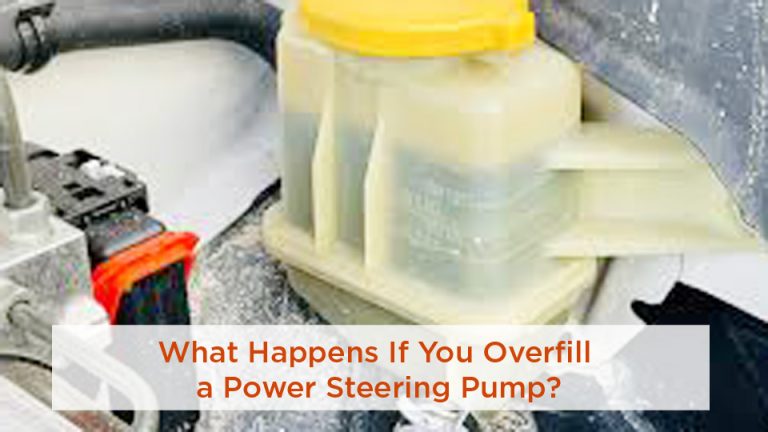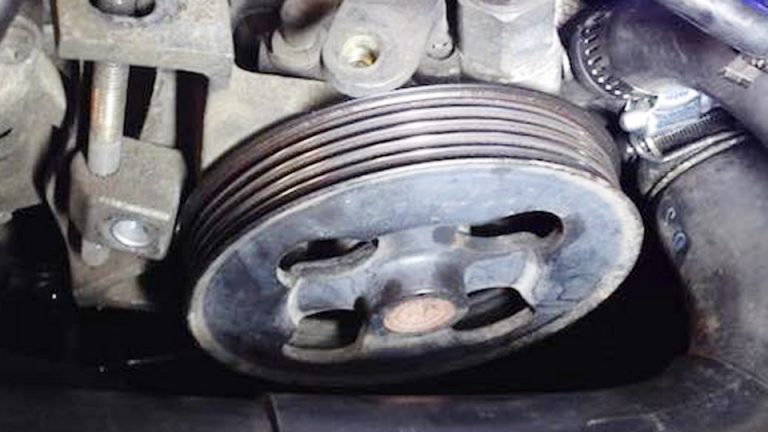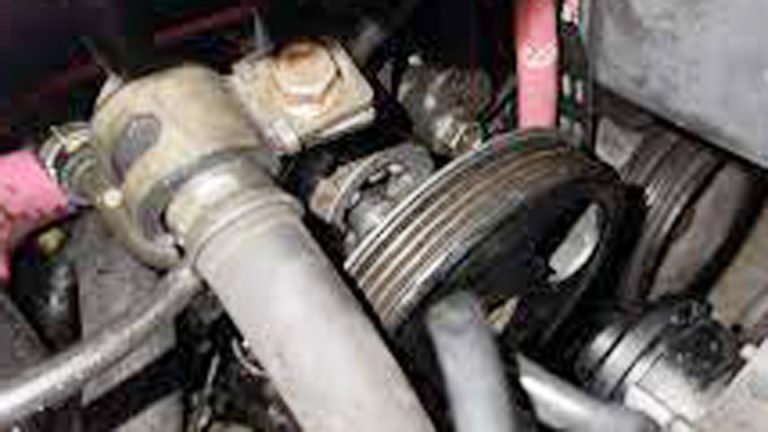It’s a question many drivers ask the moment they feel their car isn’t responding as smoothly as it used to: “Why does my steering wheel feel hard to turn?” One day, steering feels light and effortless; the next, every corner takes extra muscle. This isn’t just about comfort — stiff steering can be a real safety concern, often signaling issues with the power steering system, low fluid levels, worn belts, a failing pump, or even problems with tires and suspension.
I’ve worked on vehicles where the fix was as simple as topping up fluid, and others that required replacing major components. In either case, catching the issue early can save you money, prevent breakdowns, and keep your car handling safely and smoothly. In this guide, I’ll walk you through the most common causes and how to fix them before they turn into costly repairs.

Photo by carmechanicadelaide
Common Causes of a Hard-to-Turn Steering Wheel
When your steering wheel feels stiff, it’s usually a sign that something in the steering or suspension system isn’t playing nice. Based on my experience working on everything from compact sedans to beefy SUVs, here are the most common reasons your steering wheel might be hard to turn.
Low Power Steering Fluid
Power steering fluid is the lifeblood of most modern steering systems. It lubricates and pressurizes the system, making it easy to turn the wheel. If the fluid level is low, you’ll notice the steering feels heavy, especially at low speeds or when you’re trying to park.
Why It Happens: Leaks are the usual suspect. A cracked hose, loose clamp, or worn seal in the power steering pump or rack can let fluid escape. Sometimes, it’s just natural evaporation over time, especially if you haven’t checked the fluid in a while.
How to Diagnose: Pop the hood and check the power steering fluid reservoir, usually located near the engine. The fluid should be clear, reddish, or amber (depending on your car’s brand) and sit between the “min” and “max” lines on the reservoir. If it’s low or looks dark and gritty, you’ve got a problem.
Fix It: Top off the reservoir with the manufacturer-recommended fluid—check your owner’s manual for the right type. Then, inspect for leaks. A quick check under the car for puddles or wet spots can point you to the source. If you spot a leak, it’s time to replace the faulty hose or seal. For a temporary fix, a stop-leak additive like Lucas Power Steering Stop Leak can buy you some time, but don’t rely on it long-term.
Pro Tip: Always use the right fluid. Using the wrong type can damage seals and make the problem worse. For example, Honda vehicles often require specific Honda PSF fluid, while GM cars might need Dexron ATF.
Power Steering Pump Issues
The power steering pump is what pressurizes the fluid to help you turn the wheel effortlessly. If the pump is failing, you’ll feel it in the steering wheel—it gets stiff, and you might hear a whining noise, especially when turning.
Why It Happens: Pumps wear out over time, especially in high-mileage cars. A failing pump might not generate enough pressure, or it could be clogged with debris from old, dirty fluid.
How to Diagnose: Listen for a high-pitched whine when you turn the wheel, especially at low speeds. Check the pump for leaks or damage. If you’ve already topped off the fluid and the steering is still stiff, the pump might be the culprit.
Fix It: Replacing a power steering pump isn’t a beginner job, but it’s doable for a DIYer with some experience. You’ll need to drain the system, remove the old pump, and install a new one—expect to pay $100-$300 for a quality replacement pump from brands like ACDelco or Bosch. Flush the system with fresh fluid while you’re at it to avoid future issues.
Real-World Example: I once worked on a 2008 Ford F-150 where the owner complained about stiff steering and a loud whine. The pump was shot, and the fluid was black as tar. A new pump and a full flush had it steering like new in a few hours.
Worn or Damaged Steering Rack
The steering rack connects your steering wheel to the front wheels, translating your turns into movement. If it’s damaged or worn, turning the wheel can feel like wrestling a bear.
Why It Happens: Over time, seals in the rack can wear out, causing fluid leaks or binding. Rough roads, potholes, or neglecting maintenance can speed up the damage.
How to Diagnose: Look for uneven steering, where it’s harder to turn one way than the other. Check for fluid leaks under the car near the front wheels. If you hear a clunking noise when turning, the rack might be failing.
Fix It: Replacing a steering rack is a big job, often costing $500-$1,500 at a shop, including parts and labor. If you’re handy, you can do it yourself with a rebuilt rack from a reputable brand like Cardone. Expect 4-6 hours of work, including realigning the wheels afterward. If the damage is minor, a professional might be able to reseal the rack instead of replacing it.
Warning: Don’t ignore a failing rack. It can lead to complete steering failure, which is dangerous, especially at highway speeds.
Belt or Pulley Problems
The power steering pump is driven by a serpentine belt or a dedicated power steering belt, depending on your car. If the belt is loose, worn, or broken, the pump won’t work properly, making the steering feel heavy.
Why It Happens: Belts wear out over time, especially in harsh climates like the hot summers of Arizona or the freezing winters of Minnesota. A loose tensioner or a misaligned pulley can also cause issues.
How to Diagnose: Open the hood and inspect the belt for cracks, fraying, or glazing (a shiny, worn look). Check the tension by pressing on the belt—it should have about half an inch of give. If it’s too loose or tight, the tensioner might need adjustment or replacement.
Fix It: A new serpentine belt costs $20-$50, and replacing it is a 30-minute job for most cars. Use a belt routing diagram (usually on a sticker under the hood) to ensure proper installation. If the tensioner or pulley is bad, replace those too—OEM parts from brands like Gates are a safe bet.
Pro Tip: While you’re in there, check the condition of other belts and pulleys to avoid future headaches.
Tire Pressure or Alignment Issues
Sometimes, the problem isn’t in the steering system at all—it’s your tires. Low tire pressure or poor wheel alignment can make steering feel stiff and unresponsive.
Why It Happens: Underinflated tires increase rolling resistance, making it harder to turn the wheel. Misaligned wheels can pull the car to one side, fighting your steering input.
How to Diagnose: Check your tire pressure with a gauge—most cars recommend 30-35 PSI, but check the sticker on your driver’s door jamb for specifics. Uneven tire wear or a car that pulls to one side suggests alignment issues.
Fix It: Inflate tires to the recommended pressure. If steering is still hard, get a professional alignment at a shop—expect to pay $75-$150. For DIYers, you can do a rough alignment at home using a tape measure and string, but a shop’s laser alignment is more precise.
Real-World Example: A buddy of mine thought his Chevy Silverado’s steering rack was toast because turning was so tough. Turns out, his front tires were at 20 PSI. A quick inflate to 35 PSI, and it drove like a dream.
Diagnosing the Problem Step-by-Step
Now that you know the common causes, let’s walk through a practical diagnostic process you can do in your driveway. This step-by-step guide is based on years of troubleshooting steering issues on everything from Hondas to Dodges.
Step 1: Check Power Steering Fluid
- What You Need: A rag, power steering fluid (if low), and your owner’s manual.
- Process: Pop the hood, locate the power steering reservoir, and check the fluid level. If it’s low, top it off and look for leaks. If it’s dark or smells burnt, plan to flush the system soon.
- Time: 5-10 minutes.
Step 2: Listen for Noises
- What You Need: Just your ears.
- Process: Start the car and turn the wheel side to side. A whining noise points to a pump issue, while clunking or grinding suggests a rack or suspension problem.
- Time: 2-3 minutes.
Step 3: Inspect the Belt
- What You Need: A flashlight and a wrench (if adjusting tension).
- Process: Check the serpentine or power steering belt for wear or looseness. If it’s damaged, replace it. If it’s loose, adjust the tensioner or replace it if worn.
- Time: 10-20 minutes.
Step 4: Check Tire Pressure and Alignment
- What You Need: Tire pressure gauge, air compressor (if needed).
- Process: Measure tire pressure and inflate to the recommended PSI. Drive the car slowly to see if it pulls to one side, indicating an alignment issue.
- Time: 10-15 minutes.
Step 5: Test Drive and Observe
- What You Need: A safe, open area to drive.
- Process: Take the car for a short drive, testing steering at low and high speeds. Note when the stiffness occurs—only at low speeds (likely fluid or pump) or all the time (possibly rack or tires).
- Time: 10-15 minutes.
Table: Quick Diagnostic Chart
| Symptom | Likely Cause | First Step to Fix |
|---|---|---|
| Whining noise when turning | Low fluid or failing pump | Check fluid level |
| Clunking noise | Worn steering rack | Inspect rack for leaks |
| Steering stiff at low speeds | Low fluid or pump issue | Top off fluid |
| Car pulls to one side | Alignment or tire pressure | Check tire PSI |
| Belt squealing | Loose or worn belt | Inspect and replace belt |
Fixing the Issue Yourself vs. Going to a Shop
Once you’ve diagnosed the problem, you’ll need to decide whether to fix it yourself or take it to a professional. Here’s a breakdown to help you choose, based on my own garage experiences.
DIY Repairs
Best For: Simple fixes like topping off fluid, replacing a belt, or inflating tires.
Pros: Saves money (shops charge $100+/hour for labor), builds skills, and gives you control.
Cons: Requires tools, time, and some know-how. Mistakes can lead to bigger issues.
Tools Needed: Basic socket set, wrenches, jack stands, and fluid-specific tools (like a turkey baster for fluid flushes).
Cost: $20-$300, depending on parts (e.g., $20 for fluid, $150 for a pump).
Example: Replacing a serpentine belt on my old Toyota Camry took 20 minutes and cost $25 for a Gates belt. A shop quoted $150 for the same job.
Professional Repairs
Best For: Complex jobs like steering rack or pump replacement, or if you’re not confident in your skills.
Pros: Expertise, warranty on work, and access to specialized tools (like alignment machines).
Cons: Expensive—labor can double the cost of parts. You might wait days for an appointment.
Cost: $100-$1,500, depending on the issue (e.g., $500-$1,000 for a rack replacement).
Warning: If you’re dealing with a steering rack or pump, don’t drive the car far. A complete failure can leave you stranded or worse.
Maintenance Tips to Prevent Steering Issues
Prevention is always better than a cure, especially when it comes to steering problems. Here are some tips I’ve learned from years of keeping my cars (and friends’ cars) in top shape.
Check Fluid Regularly: Every 6 months or during oil changes, peek at the power steering fluid level and condition. Top it off if needed and look for leaks.
Flush the System: Every 50,000 miles or as recommended in your owner’s manual, flush the power steering system to remove old fluid and debris. A turkey baster and fresh fluid make this a cheap DIY job.
Inspect Belts: Check your serpentine belt every oil change (about every 5,000-7,500 miles). Replace it every 60,000-100,000 miles or if you see cracks.
Keep Tires in Check: Maintain proper tire pressure and get an alignment every 12-24 months or after hitting a big pothole. This saves your steering system and improves fuel economy.
Drive Smart: Avoid harsh turns or hitting curbs, which can stress the steering rack and suspension.
Pro Tip: If you live in a snowy state like Michigan or a dusty one like Nevada, check your steering components more often—salt and dirt can accelerate wear.
Steering Issues Across US Driving Conditions
Driving conditions in the USA vary wildly, and they can affect your steering system. Here’s how to adapt based on where you drive.
Urban Areas (e.g., New York, LA): Constant stop-and-go traffic and tight parking put extra strain on the power steering pump and fluid. Check fluid levels monthly and watch for leaks.
Rural Roads (e.g., Midwest, Texas): Gravel, potholes, and uneven roads can damage the steering rack and suspension. Inspect for clunks or looseness after rough drives.
Cold Climates (e.g., Minnesota, Maine): Freezing temperatures can thicken power steering fluid, making steering feel stiff. Use a fluid rated for cold weather and warm up the car before driving.
Hot Climates (e.g., Arizona, Florida): Heat breaks down belts and fluid faster. Check belts for cracking and fluid for discoloration every 3-6 months.
Real-World Example: A friend in Chicago had stiff steering every winter. Turns out, his power steering fluid wasn’t rated for sub-zero temps. Switching to a synthetic fluid solved the issue.
Conclusion
A hard-to-turn steering wheel isn’t just an annoyance—it’s a sign your car needs attention. Whether it’s low fluid, a worn pump, a failing rack, or something as simple as low tire pressure, diagnosing and fixing the issue can get you back to enjoying the drive. By following the steps I’ve outlined, you can pinpoint the problem and decide whether to tackle it yourself or call in a pro.
Regular maintenance, like checking fluid and belts, can prevent most issues and save you from costly repairs down the road. Next time you’re in the driver’s seat, take a moment to listen to your car—it’s trying to tell you something.
Keep a small bottle of power steering fluid in your trunk for emergencies. It’s a cheap way to avoid being stranded if you spot a leak on a long drive.
FAQ
Why does my steering wheel feel stiff only when I turn left?
This usually points to a problem in the steering rack or tie rods. Uneven wear or damage on one side can make turning harder in one direction. Check for leaks or play in the rack and get it inspected by a pro if you’re unsure.
Can low tire pressure really make steering harder?
Absolutely. Underinflated tires increase resistance, forcing you to muscle the wheel more. Check your tire pressure monthly and keep it at the recommended PSI for smoother steering and better gas mileage.
How often should I check my power steering fluid?
Every 6 months or during oil changes is a good rule of thumb. If you notice steering issues or leaks, check it sooner. Keeping the fluid topped off prevents pump and rack damage.
Is it safe to drive with a hard-to-turn steering wheel?
It depends on the cause. Low fluid or tire pressure might be okay for a short drive to a shop, but a failing rack or pump can lead to total steering failure. Diagnose the issue first and avoid long trips until it’s fixed.
Can I use transmission fluid instead of power steering fluid?
Sometimes, but only if your owner’s manual says so. Some cars (like older GMs) use ATF for power steering, but others require specific fluid. Using the wrong type can damage seals and make steering worse.



